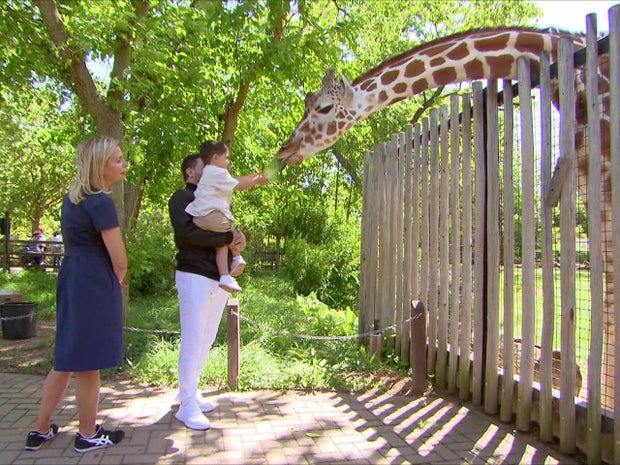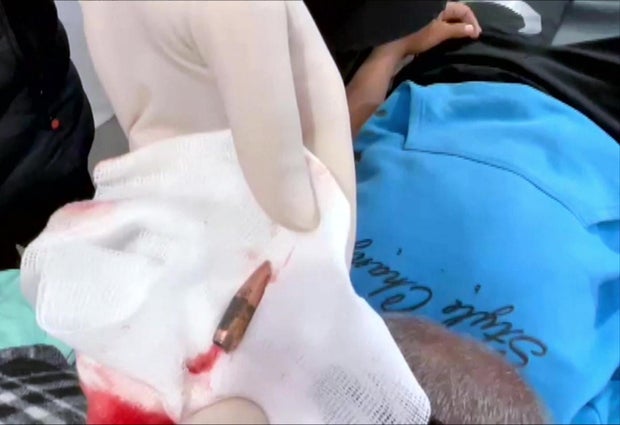Children of Gaza
It's hard not to smile watching two-year-old Jood Damo feeding giraffes at the Brookfield Zoo near Chicago. But this is just one moment of joy, in a lifetime that's already seen too much pain.
On December 26, Jood's family was living in a refugee camp in the Gaza Strip when it was hit by an Israeli airstrike. Jood's father, Ahmed, said he found his son screaming, with his right leg crushed, and his wife, Jood's mother, dead. "She was hugging Jood; she protected Jood with her body," Ahmed said.
He said he could not obtain medical treatment for his son in Gaza: "We have reached a point where there are no doctors, and there are no medicines. All I felt for Jood was that he would never be able to walk on his foot again. I was imagining that he would reach the point where his foot would be amputated."
A photo of Jood, bleeding on a dirty hospital floor, went viral:
And after weeks of coordination, the nonprofit Palestine Children's Relief Fund rescued Jood and Ahmed, bringing them some 6,000 miles away to Chicago for medical care.
UNICEF calls Gaza the most dangerous place in the world to be a child. The Palestinian territory has been under assault by Israel since October 7 of last year, when Hamas led a brutal surprise attack that killed 1,200 people, and took roughly 250 hostages. (116 of those hostages remain in Hamas captivity.)
Israel launched a counter-attack, and in the violence, more than 38,000 Palestinians – a number that includes civilians and militants – have been killed, according to the Hamas-run Health Ministry. Of those deaths, they say more than 14,000 are children. UNICEF says the death toll is likely much higher.
And UNICEF reports hundreds of thousands of children are in need of medical care.
- UNICEF chief Catherine Russell says death toll of children in Gaza is "staggering" ("Face the Nation")
- Children dying in Gaza before doctors can help, pediatrician says
But Israel has destroyed most of Gaza's hospitals, saying Hamas stores weapons in them, and hides beneath them. It's a reality that has left thousands of children trapped, desperate for help.
Tareq Hailat, head of the treatment abroad program for the Palestine Children's Relief Fund, receives messages for help on a daily basis. His organization works to get children like Jood Damo medical care. To date, Hailat's team has evacuated more than 200 children from Gaza.
Hailat showed Smith a list of children that they have been trying to evacuate; names highlighted in red indicate children who have died while on the waiting list.
Asked what children seeking medical care are doing now, Hailat replied, "Sadly, the real answer is they're dying. A broken leg here in the United States is not the same as a broken leg in Gaza. A broken leg in Gaza means that most likely you're going to have that leg amputated, which means that most likely you're gonna get an infection post that amputation, which most likely means that you're going to die."
Getting a child out of Gaza can take months. The only way to evacuate is through Egypt, and Israel requires multiple background checks before it will allow a child (who must be accompanied by a guardian) to leave. In May, Israel seized the Rafah border, the last remaining crossing point between Egypt and Gaza. Aid workers say that's made rescuing children almost impossible.
Dr. Mark Perlmutter, an orthopedic surgeon from North Carolina, and vice president of the International College of Surgeons, volunteered in Gaza from the end of April through the first half of May. Asked to describe what he witnessed in Gaza, Dr. Perlmutter replied, "All of the disasters I've seen, combined – 40 mission trips, 30 years, Ground Zero, earthquakes, all of that combined – doesn't equal the level of carnage that I saw against civilians in just my first week in Gaza."
And the civilian casualties, he said, are almost exclusively children. "I've never seen that before," he said. "I've seen more incinerated children than I've ever seen in my entire life, combined. I've seen more shredded children in just the first week … missing body parts, being crushed by buildings, the greatest majority, or bomb explosions, the next greatest majority. We've taken shrapnel as big as my thumb out of eight-year-olds. And then there's sniper bullets. I have children that were shot twice."
"You're saying that children in Gaza are being shot by snipers?" asked Smith.
"Definitively," said Dr. Perlmutter. "I have two children that I have photographs of that were shot so perfectly in the chest, I couldn't put my stethoscope over their heart more accurately, and directly on the side of the head, in the same child. No toddler gets shot twice by mistake by the 'world's best sniper.' And they're dead-center shots."
In fact, more than 20 doctors recently in Gaza also told "Sunday Morning" about gunshot wounds to children.
One American doctor told us he even reviewed CT scans to confirm what he saw because he "didn't believe that this many children could be admitted to a single hospital with gunshot wounds to the head." Some shootings have been captured on video.
The Israel Defense Forces declined our requests for an on-camera interview. But in an email, a spokesperson told CBS News, "The IDF has never, and will never, deliberately target children," adding, "Remaining in an active combat zone has inherent risks." And the IDF stressed that it calls for the evacuation of civilians from combat zones.
The UN reports that, to date, more than 80 percent of Gaza's population has been displaced, and the majority of its buildings destroyed, a reality which has taken its own toll on the well-being of children.
And what about the emotional wounds? "How can you measure that? I can't measure my own," Dr. Perlmutter said. "How do you be an orphan, watching your family, you know, melted in front of you and shredded in front of you – how do you fix that, ever fix that?"
In fact, so many Palestinian children have had family members killed that doctors created a shorthand term: WCNSF (Wounded Child No Surviving Family).
Last month, speaking in Washington, D.C., other American doctors echoed Dr. Perlmutter's calls for help. Dr. Feroze Sidwa said, "We've described it as a catastrophe, a nightmare, a hell on Earth. It's all of these, and worse."
Dr. Zena Saleh said, "We didn't even have hand sanitizer or alcohol or soap most of the time."
"While we're there, we're listening to, you know, 'Aid is getting in. We're taking care of civilians. They're not being targeted,'" said Dr. Adam Hamawy. "And yet, we're witnessing a completely different story."
Some medical professionals who spoke to "Sunday Morning" requested their identities be kept private, as some plan to return again to Gaza. A Virginia-based doctor told us, "We all see gunshots in the U.S., but we have never seen anything like the gunshots to kids in Gaza." Another Virginia-based anesthesiologist told CBS News that, over his two weeks in Gaza, he saw single gunshot wounds to kids on a daily basis (he guessed at least 30 total).
One Chicago-based doctor told us, "I thought these kids were in the wrong place at the wrong time, like sadly, some of the kids we treat in Chicago. But after the third or fourth time, I realized it was intentional; bullets were being put in these kids on purpose."
Dr. Perlmutter noted that he saw, for dozens of miles, 18-wheelers parked bumper-to-bumper, their engines off or idling, outside of Gaza. "Food or health care could not get in," he said.
Smith asked, "How many kids are in danger of starvation in Gaza?"
"All of them," he replied. "Absolutely all of them."
United Nations experts have accused Israel of carrying out a "targeted starvation campaign." But Israeli officials say they've allowed the delivery of more than 600,000 tons of food and supplies, "with the goal of bringing as much aid into the Gaza Strip as possible."
- Israel blames Gaza starvation on U.N. as UNICEF says a third of Gazan infants and toddlers acutely malnourished
- Save the Children CEO says aid getting into Gaza is "woefully inadequate" ("Face the Nation")
Injured children continue to trickle into the United States. Last weekend "Sunday Morning" was there when a 13-year-old girl, Jana Yaseen, arrived in Los Angeles. Despite the warm welcome she and others received, these kids are only scheduled to stay until their treatment is complete.
As for Jood Damo, he's regained his ability to walk, but still has months of medical treatments ahead of him. His father, Ahmed, said he is grateful for the help of people like Tareq Haliat, from the Palestine Children's Relief Fund, even though there are some wounds that can never be made whole. "All the children of Gaza suffer like Jood, whether they are injured or wounded or not," he said. "They are all suffering, Jood is just one of them."
For more info:
- Palestine Children's Relief Fund
- Dr. Mark Perlmutter, International College of Surgeons
- HEAL Palestine
Story produced by Sara Kugel. Editor: Ed Givnish.








